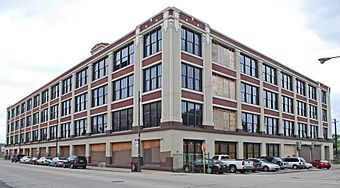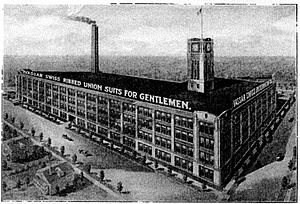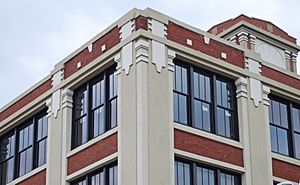Vassar Swiss Underwear Company Building facts for kids
Quick facts for kids |
|
|
Vassar Swiss Underwear Company Building
|
|

Facade from northwest, showing 1913 main building (left) and 1923 western addition (right)
|
|
| Location | 2545 W. Diversey Ave., Chicago, Illinois |
|---|---|
| Area | 0.5 acres (0.20 ha) |
| Built | 1914 |
| Architect | Lawrence G. Hallberg, Sr.; Lawrence G. Hallberg, Jr. |
| NRHP reference No. | 07000859 |
| Added to NRHP | September 17, 2008 |
The Vassar Swiss Underwear Company Building is a large factory building located in Chicago, Illinois. It's also known as the Cooper Lamp Building. This historic building was added to the National Register of Historic Places in 2008. As of 2010, it was being turned into the Green Exchange. This new space is designed for small businesses that focus on natural products and helping the environment.
Contents
The Vassar Swiss Underwear Company Story
Around the late 1800s, a type of clothing called the union suit became very popular. It was a one-piece undergarment. George E. Rutledge, who lived in Chicago, saw a chance to make it better. He worked on the design, making it stronger and more comfortable.
His changes made the union suit less bulky and cheaper to make. In 1900, Rutledge received a patent for his improved design. He also created special machines to produce it. That same year, he teamed up with Emil A. Basener and Frederick S. McCoy. They started the Vassar Swiss Underwear Company with $10,000. Their goal was to make Rutledge's union suits and other high-quality men's underwear.
Moving the Factory to Chicago
In 1903, the company moved its production about 80 miles (130 km) west to Rochelle, Illinois. This was done to avoid labor problems. The company grew bigger over time. In 1912, a company called Northwestern Knitting Company bought Vassar Swiss. Northwestern later became Munsingwear.
Soon after buying Vassar Swiss, Northwestern decided to increase production. They moved Vassar Swiss back to Chicago. They hired Stewart Hodges, who was good at building factories, to construct a new plant. Vassar Swiss would then rent this new building.
Hodges chose a spot on Diversey Avenue. It was close to train tracks and the Maplewood station. He also hired his father-in-law, Lawrence G. Hallberg, to design the new factory. Construction started in September 1913 and finished in April 1914.
Growing and Changing Products
Vassar Swiss did very well in its new Chicago location. George Rutledge, who was now a vice-president, worked with other designers. They continued to improve the original union suit. In 1923, the company added a new section to the western part of their building. This addition, also designed by Hallberg, was for their box factory and shipping area.
Over the next 40 years, the company changed what it made. Union suits became less popular. Instead, briefs became their main product. Vassar Swiss eventually bought the building from Stewart, after renting it for many years. Rutledge retired in 1937.
The company shortened its name to "Vassar Company." Then, in 1951, it became "Vassarette." In 1967, the company moved its production from Chicago to Paris, Texas. Today, the Vassarette name is owned by Vanity Fair Brands, and they make women's underwear.
What Happened to the Building Later
After Vassarette moved out, the building was bought by the Frederick Cooper Lamp Company. This company made fancy lamps. Cooper used the building for manufacturing until 2005. Then, they closed down and sold the building to Baum Brothers LLC.
Baum Brothers started to change the building. They wanted to create a space for small businesses that focus on natural products and the environment. They called this new project the Green Exchange. As of 2010, the changes were still being made.
What the Vassar Swiss Building Looks Like
The Vassar Swiss Underwear Company Building is a great example of a four-story industrial building. It's made of reinforced concrete, which means concrete with steel bars inside to make it stronger. The building was built in two parts, but they look like one seamless structure.
The first part, built in 1913, is about 160 feet (49 m) long and 300 feet (91 m) wide. The 1923 addition is 103 feet (31 m) long and 204 feet wide. The whole building has a huge area of 250,000 square feet. It's shaped like a "U" from above. The two arms of the "U" are different lengths. They face the diagonal railroad tracks at the back and create a narrow courtyard in the middle.
You can easily see the concrete construction in the building's outside details. There are clear horizontal and vertical lines. Even though the building is very long, the design makes it look taller. This is because of the vertical pilasters (flat, column-like decorations). These pilasters have stylish Arts and Crafts designs at the top. The corners of the building have even taller pilasters. They stick up above the roofline and have special stones above the windows.
The building also has a unique four-story tower. This tower hides the water tank on the roof. It's made of brick, terra cotta (a type of baked clay), and concrete. The top of the tower has a stepped design. It originally had a clock on each side.







